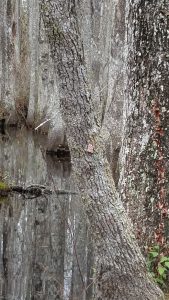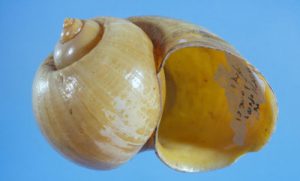
Wetland area on Hurlburt Field Air Force Base has been invaded by channeled apple snails. Photo Credit: Lorraine Ketzler
When you think of snails, you probably aren’t thinking about scary monsters that have been unleashed to terrorize us all. I’m here to warn you that you should. The channeled apple snail (Pomacea canaliculata) is a known agricultural pest that competes with native snail species. In our area (panhandle Florida, Hurlburt Field to be exact) this snail is consuming unknown quantities of plant material in our sensitive wetlands. If you didn’t know, Hurlburt Field Air Force Base is one of the last places on Earth where the endangered reticulated flatwoods salamander (Ambystoma bishopi) can still be found, and this endangered salamander relies on healthy wetlands and ephemeral ponds for breeding.
So why should you worry? Just think about how snails eat: snails have a tongue (a radula) with teeth-like structures (denticles) they use to rasp or drill into their food. Normally, nobody would really worry about what snails are eating; they’re snails, right? But, here comes the scary part: when there are many snails, all eating and breeding and growing and eating, they consume a lot of material. And, what once was a cute little snail in your 10-gallon aquarium becomes a rampaging menace when you dump your tank out in the ditch next to your house and the snail escapes into the wild!

Channeled applesnail, Pomacea canaliculata (Lamarck, 1819). Photograph by Jeffrey Lotz, DPI. Click on the picture for more information on apple snails in Florida.
Ok, let’s be honest, it’s not like snails are running wild. I mean, they’re as slow as…well…snails. But what we believe began as a dumped aquarium pet some years ago has become a large population that is expanding into our wetlands. Although it is currently not found in our salamander breeding ponds (whew!), if we don’t do something to stop it, it soon could be. Here we are in Florida, where we have many examples of dumped or escaped animals that are breeding and growing and eating and breeding with no population control. This is one heck of a great example of an invasive species.
So, what are we going to do about this creeping, slimy, menace? Well, in our case, we called our invasive species contractor, and this year we will begin a labor-intensive project to control this species’ population on Hurlburt Field. We could use your support! Please use the IveGot1 app or EDDMaps to report local encounters with channeled apple snails. And, please DO NOT release non-native wildlife into the wild!
Guest Author:
Lorraine “Rain” Ketzler
Associate Wildlife Biologist
Hurlburt Field Natural Resources Manager
- Killer Turkey Food Plot - January 31, 2025
- Common Wildlife Food Plot Mistakes - November 8, 2024
- Seasonality of Prescribed Burning Workshop - February 23, 2024
